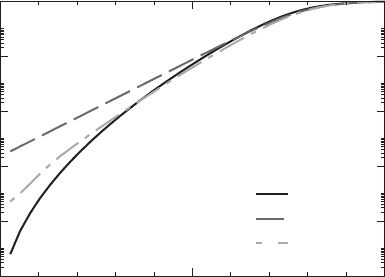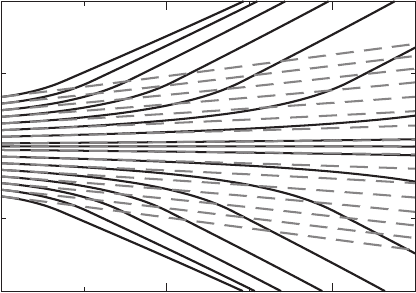Chattaraj P.K. (Ed.) Quantum Trajectories
Подождите немного. Документ загружается.


364 Quantum Trajectories
In principle, the limit of any δ-function sequence [23] can be used in Equation 23.9, for
example the sinc-function sequence [24]. The Gaussian-based δ-function sequence,
δ(x) = lim
γ→∞
γ
π
exp(−γx
2
), (23.10)
can be advantageous for many trajectory-based propagation methods (including the
AQPapproach) [3–7,9], because they are exact for Gaussian wavepackets and because
the initial wavefunction localized in coordinate space can be efficiently represented
with trajectories. Therefore, we approximate the eigensolution Equation 23.9 with
φ
±
(x) =
2γ
π
1/4
exp(−γx
2
)
1
√
2
± ı
2γx
, λ =
γ
m
√
8π
, (23.11)
choosing a large value of the width parameter γ which gives N (E) independent of γ.
Short-time analytical propagation in the parabolic approximation to the barrier can
be introduced to widen the highly localized initial wavefunction Equation 23.11 as
described in Ref. [15].
23.2.1 R
EAL-TIME VARIATIONAL APPROXIMATE QUANTUM POTENTIAL
The AQP method [9] is based on the quantum trajectory formulation [25, 26] of the
usual time-dependent Schrödinger equation (TDSE),
−
2
2m
∇
2
+ V
ψ(x, t ) = ı
∂
∂t
ψ(x, t ). (23.12)
The wavefunction expressed in terms of the real amplitude A(x, t) and the real phase
S(x, t),
ψ(x, t ) = A(x, t )e
ıS(x,t)/
, (23.13)
is represented by an ensemble of trajectories characterized at time t by positions x
t
,
momenta p
t
and action functions S
t
. The trajectory momentum is the gradient of the
wavefunction phase,
p(x, t) =∇S(x, t). (23.14)
In the Lagrangian frame of reference,
d
dt
=
∂
∂t
+
p
m
∇, (23.15)
Newton’s laws of motion for the quantum trajectories follow from the TDSE:
dx
t
dt
=
p
t
m
,
dp
t
dt
=−∇(V + U ), (23.16)
dS
t
dt
=
p
2
t
2m
− (V +U ). (23.17)

Approximate Quantum Trajectory Dynamics in Imaginary and Real Time 365
The function U denotes the quantum potential,
U =−
2
2m
∇
2
A(x, t )
A(x, t )
, (23.18)
which vanishes in the classical limit → 0 for nonzero wavefunction amplitudes.
The wavefunction density A
2
(x, t ) satisfies the continuity equation which, taking into
account evolution of the volume element δx
t
associated with each trajectory,
δx
t
= δx
0
exp
t
0
∇p
τ
m
dτ
, (23.19)
results in conservation of the probability within δx
t
, i.e., of the trajectory “weight”
w(x
t
),
w(x
t
) = A
2
(x
t
)δx
t
,
dw(x
t
)
dt
= 0. (23.20)
Therefore, A(x, t ) can be reconstructed from trajectory positions and weights.
The concept of the trajectory weights is central to the approximate implementa-
tion of Equations 23.16 and 23.17 of Garashchuk and Rassolov [9, 27]. The AQP
(labeled
˜
U) is determined variationally, thus conserving the energy of the trajectory
ensemble, from linearization of the nonclassical component, r(x, t ), of the momentum
operator:
r(x, t) =
∇A(x, t )
A(x, t )
. (23.21)
Minimization of (r −˜r)
2
, where ˜r is a linear function, has a solution in terms of the
moments of the trajectory distribution:
r(x, t) ≈˜r(x, t) =−
x −x
t
2(x
2
t
−x
2
t
)
. (23.22)
˜
U and its gradient are determined analytically,
˜
U =−
2
2m
˜r
2
(x, t ) +∇˜r(x, t)
. (23.23)
The AQP method is exact for Gaussian wavepackets and describes wavepacket
bifurcation, moderate tunneling, and zero-point energy for times dependent on the
anharmonicity of V . It is numerically cheap and stable due to the “mean-field”-like
procedure of determining AQP: with Equation 23.20 the expectation values in Equa-
tion 23.22 are computed as sums over trajectories labeled with index k,
Ω(x)
t
=
Ω(x)A
2
(x, t )dx =
Ω(x
t
)A
2
(x
t
)δx
t
=
k
Ω(x
(k)
t
)w
(k)
. (23.24)
Using the mixed wavefunction representation, the correlation functions of Equa-
tion 23.7 can also be computed as single sums over trajectories, without finding
A(x, t ).

366 Quantum Trajectories
23.2.2 WAVEPACKET EVOLUTION AND COMPUTATION OF CORRELATION FUNCTIONS
IN THE
MIXED COORDINATE/POLAR REPRESENTATION
To propagate the flux operator eigenfunctions Equation 23.11, we use the mixed
coordinate/polar wavefunction representation introduced in Ref. [16],
φ(x, t ) = ψ(x, t )χ(x, t), (23.25)
where ψ(x, 0) is a normalized Gaussian and χ(x, 0) is its polynomial prefactor. The
coordinate part, χ(x, t), is represented in theTaylor basis
!
f (x) ={1, x, ...}of size N
a
,
χ(x, t ) =
!
f (x) ·!a(t). (23.26)
The polar part, ψ(x, t), is an initially nodeless function solving the TDSE Equa-
tion 23.12. Substitution of Equations 23.25 and 23.26 into the TDSE for φ(x, t),
multiplication by ψ
∗
(x, t )
!
f (x) and integration over x gives the matrix equation for
d !a/dt,
ı
!
f ⊗
!
f
d !a
dt
=
∇
!
f ⊗∇
!
f
2m
− ı
p
!
f ⊗∇
!
f
m
!a. (23.27)
All integrals are evaluated according to Equation 23.24. For example, the matrix
elements of the last term of Equation 23.27 are
p
!
f ⊗∇
!
f
ij
=
k
p
(k)
t
f
i
(x
(k)
t
)∇f
j
(x
(k)
t
)w
(k)
.
The polar part ψ(x, t ) is described in terms of quantum trajectories, initiated
with zero initial momenta at positions sampling the Gaussian part of φ
±
(x) given
by Equation 23.11, propagated in the presence of AQP. The functions χ
±
(x,0) =
a
1
(0) ± a
2
(0)x are the polynomial prefactors of φ
±
(x). Restricting χ
±
to a linear
form, for symmetric V the coefficients are:
a
1
(t) = a
1
(0), a
2
(t) = a
2
(0) exp
−
t
0
px
τ
+ ı/2
mx
2
τ
dτ
. (23.28)
The mixed representation reduces the propagation error and cost, because it allows
for stable trajectory dynamics of the nodeless (at least for short time) ψ(x, t) and it
simplifies calculations of the correlation functions, C
±
, in Equation 23.7. C
±
can be
expressed via the trajectory weights if the evolution operator is equally partitioned
between bra and ket,
C
±
(2t) =
k
w
(k)
e
2ıS
(k)
t
a
1
(t) + a
2
(t)x
(k)
t
a
1
(t) ∓ a
2
(t)x
(k)
t
. (23.29)
23.2.3 N
UMERICAL ILLUSTRATION
Here the wavepacket formulation of Equations 23.7, 23.8, and 23.11 is used to com-
pute the reaction probability, N (E), for a one-dimensional model of the H
3
transition
state—for the Eckart barrier scaled to have m = 1,

Approximate Quantum Trajectory Dynamics in Imaginary and Real Time 367
V = V
0
cosh
−2
αx. (23.30)
In scaled units the barrier height is V
0
= 16 and α = 1.3624 a
−1
0
.
The purpose was to assess the accuracy of the AQP description of the tunnel-
ing regime. The implementation was not optimized. The trajectory positions were
distributed uniformly. For linear χ(x, t), the only quantities needed to determine the
quantum force and the polynomial coefficient a
2
in Equation 23.28 are x
2
and px,
which could be computed with relative errors below 2 ×10
−5
with 1000 trajectories.
We needed many more trajectories (10
6
) to obtain low-tunneling probabilities with
uniform sampling. The numerical cost scales linearly with the number of trajectories.
In principle, the AQP parameters and coefficients !a can be simply stored from a cal-
culation with a few thousand trajectories and used to propagate a larger number of
independent trajectories, possibly, with more effective trajectory sampling.
The cumulative reaction probability, N(E), obtained for γ = 1000 a
−2
0
is shown
in Figure 23.1. The trajectories were propagated up to t = 1.5, which, due to the
doubling of time in Equation 23.29, would be sufficient to resolve probabilities above
10
−9
in a conventional QM wavepacket calculation. For energies below V
0
the AQP
probabilities above 10
−5
were quite accurate. The AQP probabilities below this value
were too high. Nevertheless, there was a noticeable improvement over the parabolic
barrier approximation: for E = 0.52, the lowest energy resolved, the parabolic barrier
dynamics overestimated N (E)by2×10
4
, while the AQP probability was 200 times
smaller than that. As argued in Ref. [9], out of the two approximations made—the
linear quantum force and the linear form of χ(x, t)—the former is the main source
of error.
10020
Energy
1e-10
1e-08
1e-06
0.0001
0.01
1
N(E)
Analytical
Parabolic
AQP
FIGURE 23.1 The cumulative reaction probability, N(E), for the Eckart barrier obtained
from propagation of the flux eigenvectors using the AQP trajectory dynamics and mixed wave-
function representation. A comparison is made with the analytical QM probability and with
the probability derived from the analytical wavefunctions evolving in the parabolic potential
in Equations 23.7 and 23.8.

368 Quantum Trajectories
23.3 TRAJECTORY DYNAMICS IN IMAGINARY TIME WITH
THE MOMENTUM-DEPENDENT QUANTUM POTENTIAL
Direct computation of the reaction rate constants according to Equations 23.3 and 23.4
requires Boltzmann evolution of wavefunctions, equivalent to propagation in imagi-
nary time. Another type of problem solvable in imaginary time is the determination
of low-lying energy levels and eigenfunctions [28], in particular of the energy levels
in high-dimensional systems with Monte Carlo methods [29–31]. The approach is
based on the simple fact that in imaginary time,
ˆ
H ψ(x, τ) =−
∂ψ(x, τ)
∂τ
, τ > 0 (23.31)
the higher energy components of a wavefunction ψ(x, τ) decay faster than the lower
energy components: a wavefunction expressed in terms of the eigenstates {ψ
k
} of
ˆ
H
(E
k
> 0),
ˆ
H ψ
k
(x) = E
k
ψ
k
(x), ψ(x, τ) =
k
c
k
e
−E
k
τ
ψ
k
(x), (23.32)
decays to the lowest energy state of the same symmetry. Some recent examples are
calculations performed for malonaldehyde [32] and for CH
+
5
[33].
Substitution of the time variable, t →−ıτ (τ > 0), transforms the real-time
TDSE Equation 23.12 into the diffusion Equation 23.31. In semiclassical treatments
of Equation 23.31 [34, 35] transformation of p →−ıp and S →−ıS, led to the
classical equations of motion of trajectories in the “inverted” potential (the nega-
tive of the original V ). The same transformation of Equations 23.16, however, leads
to singular dynamics of a Gaussian wavefunction [36]. Such behavior is related to
the nonunique representation of a real wavefunction in terms of the amplitude and
“phase,” as Equation 23.13 becomes
ψ(x, τ) = A(x, τ)e
−S(x,τ)/
,
and re-partitioning of the wavefunction between A and S to avoid singularities was
successfully employed.
For a real positive wavefunction we use an unambiguous exponential form,
ψ(x, τ) = e
−S(x,τ)/
. (23.33)
The wavefunction Equation 23.33 is the same as in the Zero Velocity Complex Action
method of Ref. [37] implemented in imaginary time on a fixed grid.
23.3.1 E
QUATIONS OF MOTION
Substitution of the wavefunction Equation 23.33 into Equation 23.31 and division by
ψ(x, τ) gives
∂S(x, τ)
∂τ
=−
1
2m
(
∇S(x, τ)
)
2
+ V +
2m
∇
2
S(x, τ). (23.34)

Approximate Quantum Trajectory Dynamics in Imaginary and Real Time 369
Using τ as a time variable and defining the trajectory momentum by Equation 23.14
in the Lagrangian frame of reference Equation 23.15, Equation 23.34 leads to the
following equations of motion,
dx
dτ
=
p
m
,
dp
dτ
=∇(V + U ). (23.35)
Compared to the real-time equations 23.16 and 23.18, in imaginary time we have the
“inverted” potential and the MDQP,
U(x, τ) =
2m
∇
2
S =
∇p
2m
. (23.36)
Note that imaginary-time U (x, τ) is proportional to /m and, thus, vanishes in the
classical limit as its real-time counterpart Equation 23.18. In many dimensions Equa-
tion 23.36 generalizes to U (!x, τ) =
!
∇·
!
∇S/(2m). Evolution of the imaginary-time
action function is
dS
dτ
=
p
2
2m
+ V +U , (23.37)
and the energy of a trajectory is
ε =
∂S
∂τ
=−
p
2
2m
+ V +U . (23.38)
Remarkably, for the wavefunction Equation 23.33 evolution of the volume ele-
ment δx
τ
given by Equation 23.19 cancels the contribution of MDQP to the average
quantities,
Ω=
∞
−∞
Ω(x)e
−2S(x)/
dx =
k
Ω(x
(k)
τ
)e
−2
˜
S
k
/
δx
(k)
0
. (23.39)
˜
S indicates the “classical” action function computed along the quantum trajectory,
˜
S
τ
=
τ
0
p
2
t
2m
+ V (x
t
)
dt. (23.40)
For a Gaussian wavefunction evolving in a quadratic potential, S(x, τ) is a quadratic
function of x, p(x, τ) is linear in x, U is a time-dependent constant and the quan-
tum force, ∇U , is zero. Therefore, average x-orp-dependent quantities of classical
(U = 0) and QM evolutions are the same. This quantum/classical similarity was one
of the motivations behind the real-time Bohmian mechanics with Complex Action
(BOMCA) in complex space [38].
23.3.2 A
PPROXIMATE IMPLEMENTATION AND EXCITED STATES
To implement Equations 23.35 and 23.37 one has to know derivatives of p determining
U and ∇U . Since our goal is a cheap approximate methodology, we find derivatives
from the least squares fit [39] to p(x, τ) weighted by ψ
2
(x, τ). Representing p(x, τ)

370 Quantum Trajectories
in a small basis
!
f (x) of size N
b
, p(x, τ) ≈
!
f (x) ·
!
b(τ), the optimal coefficients
!
b
minimizing (p −
!
f ·
!
b)
2
are
!
b = M
−1
!
P . (23.41)
M is a time-dependent symmetric matrix of the basis function overlaps,
M
ij
=f
i
|f
j
=
k
f
i
(x
(k)
τ
)f
j
(x
(k)
τ
) exp(−2
˜
S
(k)
τ
)δx
(k)
0
. (23.42)
The vector
!
P includes the trajectory momenta averaged with the basis functions,
P
i
=pf
i
=
k
p
(k)
τ
f
i
(x
(k)
τ
) exp(−2
˜
S
(k)
τ
)δx
(k)
0
. (23.43)
Placing the minimum of V at x = 0 we use the Taylor basis,
!
f (x) = (1, x, x
2
, ...)
T
, (23.44)
to determine MDQP and to evolve wavefunctions with nodes in the mixed coordinate
space/trajectory representation analogous to Equation 23.25.
The nodeless ψ(x, τ) solving Equation 23.31 evolves in imaginary time into the
ground state wavefunction according to Equation 23.32. For χ(x, τ) represented in a
basis
!
f (x) of size N
c
,
χ(x, τ) =
!
f (x) ·!c(τ), (23.45)
the time-dependent coefficients !c are obtained from Equation 23.31 proceeding as in
Section 23.2,
d !c
dτ
=−
2m
M
−1
D!c. (23.46)
D is the matrix of the basis function derivatives,
D
ij
=∇f
i
|∇f
j
=
k
∇f
i
(x
(k)
τ
)∇f
j
(x
(k)
τ
) exp(−2
˜
S
(k)
τ
)δx
(k)
0
. (23.47)
To find the ground state of a system we start with a Gaussian ψ(x, 0), since its
evolution is exact in a quadratic potential for the smallest meaningful basis, N
b
= 2.
Although a linear approximation to p(x, τ) gives zero quantum force, which does not
affect the positions of the trajectories, MDQPis still required to define the total energy.
To obtain N
s
eigenstates we evolve N
s
mixed representation functions φ
n
= χ
n
ψ
(n = 1, ..., N
s
). The functions χ
n
are represented in the Taylor basis Equation 23.44,
and their coefficients are written as a matrix C = (!c
1
, !c
2
, ..., !c
N
s
). The number of
states, N
s
, is no larger than the basis size, N
c
. The initial functions χ
n
will have the
correct number of nodes, if the initial values C
ij
are chosen for φ
n
(x, 0) to be, for
example, the eigenfunctions of a harmonic oscillator.At each time step wavefunctions
of the lower energy are projected out:
χ
new
j
= χ
j
−
k,k<j
χ
j
|χ
k
χ
k
, (23.48)

Approximate Quantum Trajectory Dynamics in Imaginary and Real Time 371
which in terms of C and the overlap matrix Equation 23.42 is
C
new
ij
= C
ij
−
k,k<j
χ
j
|χ
k
C
ik
, χ
j
|χ
k
=(C
T
MC)
jk
. (23.49)
Both the determination of MDQP and the evolution of C require inversion of the
overlap matrix M. For N
c
= N
b
the calculation of the excited states requires little
effort in addition to the quantum trajectory propagation. The outlined approach is
approximate and is expected to work for a few low-energy eigenstates where the
modest basis size is sufficiently accurate.
23.3.3 C
ALCULATION OF THE ENERGY LEVELS
The approximate MDQP approach is illustrated for anharmonic systems, which
proved to be challenging for real-time exact and approximate quantum trajectory
dynamics [40–42]. The difficulty is the inherent instability of the real-time Bohmian
trajectories describing stationary eigenstates: such trajectories should not move, there-
fore classical and quantum forces have to cancel each other exactly. Otherwise, small
displacements of the trajectory positions lead to rapid “decoherence” of the trajecto-
ries and, consequently, to the loss of quantum effects. In contrast, the imaginary-time
trajectories are not stationary—their dynamics reflects the decay of the wavefunction.
For the harmonic oscillator, the imaginary-time trajectories “roll off” a parabolic bar-
rier, which is the inverted well centered at x = 0, as shown on Figure 23.2. The same
is qualitatively true for anharmonic single-well potentials in one dimension.
0 0.2 0.4
Time
–10
0
10
Position
FIGURE 23.2 Imaginary-time quantum trajectories for the quadratic (dash) and quartic (solid
line) oscillators. The quantum potential is found approximately using N
b
= 4 for the latter
potential.

372 Quantum Trajectories
TABLE 23.1
The Energy Levels (n = 0, ..., 3) for the Anharmonic Well of Equation 23.50
Obtained from the Imaginary-Time QuantumTrajectory Dynamics.The Bottom
Line Contains the Exact QM Values from the Diagonalization of the Hamilto-
nian Matrix. In the HarmonicApproximation to the Potential, the Energy Levels
are E
quad
n
= n + 1/2
N
b
N
c
E
0
E
1
E
2
E
3
2 4 0.76007 2.3139 4.5298 7.1670
4 4 0.80358 2.7371 5.2856 8.2111
6 6 0.80375 2.7379 5.1829 7.9435
QM 0.80377 2.7379 5.1719 7.9424
For illustration we consider a particle of mass m = 1 a.u. in a well with quartic
anharmonicity [36],
V = x
4
+ x
2
/2. (23.50)
The parameter γ = 1a
−2
0
specifies a Gaussian initial wavefunction,
ψ(x,0)=
2γ
π
1/4
e
−γx
2
, (23.51)
evolved up to τ = 1.0 a.u. using 500 trajectories. The trajectories corresponding to
V of Equation 23.50 and its quadratic part, V
quad
= x
2
/2, are shown on Figure 23.2.
Four basis functions, N
b
= 4, were used to define the MDQP for the full V . The
trajectories spread out faster in the anharmonic case, but the overall behavior is
similar to the dynamics in V
quad
.
Four lowest energy levels and wavefunctions were computed using four and six
functions to represent χ
n
. The initial values of C were taken as for the excited states of
the harmonic oscillator of frequency w = 2γ. The ground state energy of V exceeds
that of V
quad
by 60%. The linear fitting (N
b
= 2) of the momentum, exact for the
harmonic oscillator, recovers 86% of the difference. Increasing N
b
gives energies
within four significant figures of the exact QM calculation for nearly all levels as
summarized in Table 23.1.
The quantum trajectory results were essentially the same for γ = 2 and 0.5 a
−2
0
.
In general, the decay time and convergence to the ground state will depend on the
closeness of the initial wavefunction, ψ(x, 0), to the ground state and on the energy
levels. To obtain the highest energy eigenstate, n = 3, the projection procedure of
Equation 23.48 necessitated time steps as small as dτ = 10
−4
. This eigenstate is the
fastest to decay and, if the lower energy components are not removed from φ
3
(x, τ),
which is a mixture of eigenstates, very frequently, then this wavefunction can decay
to a lower energy eigenfunction.

Approximate Quantum Trajectory Dynamics in Imaginary and Real Time 373
TABLE 23.2
The Energy Levels for the Double Well for n = 0, ..., 3, Obtained with Approx-
imate MDQP, N
b
= N
c
= 6, and by the Diagonalization of the Hamiltonian
Matrix. The Initial Width Parameter is a = 0.75. The Normalized Energies of
φ
n
are Computed at Time τ Listed in the Second Column
m [a.u.] τ [a.u.] E
0
E
1
E
2
E
3
1 2.0 0.397 1.122 2.395 3.842
QM 0.397 1.122 2.378 3.841
20 8.0 0.133 0.152 0.345 0.473
10.0 0.131 0.152 0.348 0.479
QM 0.133 0.152 0.332 0.465
The double well of Ref. [43], considered for m = 1 and m = 20,
V = (x
2
− 1)
2
/4, (23.52)
presents a more challenging application. As m is increased the ground state function
changes from a single peak to a double peak. The trajectory dynamics is more compli-
cated, because unlike purely divergent trajectories of single wells, in the double well
some trajectories stay in the barrier region. For m = 20, approximation of p(x, τ)
within a small basis did not give fully converged eigenfunctions. Using larger bases,
in principle, should give converged eigenvalues, but this was not pursued as it seemed
impractical.
Table 23.2 shows the four lowest energy levels computed with N
b
= N
c
= 6.
The initial width parameter is γ = 0.75 a
−2
0
for all calculations. The agreement of
the wavefunction energies with the exact QM energy levels is fairly good, though the
energies of φ
n
for m = 20 weakly depend on τ after initial decay. The accuracy of the
lower energy levels, which is better than 1.5%, resolves the E
1
−E
0
energy splitting
of 0.02 a.u.; the accuracy for n = 2 and 3 is 5 and 3%, respectively. The accuracy for
the m = 1 system is better than 1% for all levels. The ground state wavefunctions for
m = 1 and m = 20 are shown in Figure 23.3. Note that the double peak for m = 20
has evolved from the Gaussian function (without the polynomial prefactors).
23.4 COMPUTATION OF REACTION RATES FROM
THE IMAGINARY AND REAL-TIME QUANTUM
TRAJECTORY DYNAMICS
Now we are ready to compute the reaction rate constants using Equation 23.4 within
the approximate quantum trajectory dynamics in real and imaginary time and the
mixed wavefunction representation [44]. Boltzmann evolution of the singular flux
operator eigenvectors composed of all energy components—the infinite temperature
situation—can be viewed as “cooling.” Due to rapid decay of the high-energy com-
ponents the wavefunctions become nonsingular for any finite temperature. In fact, we
